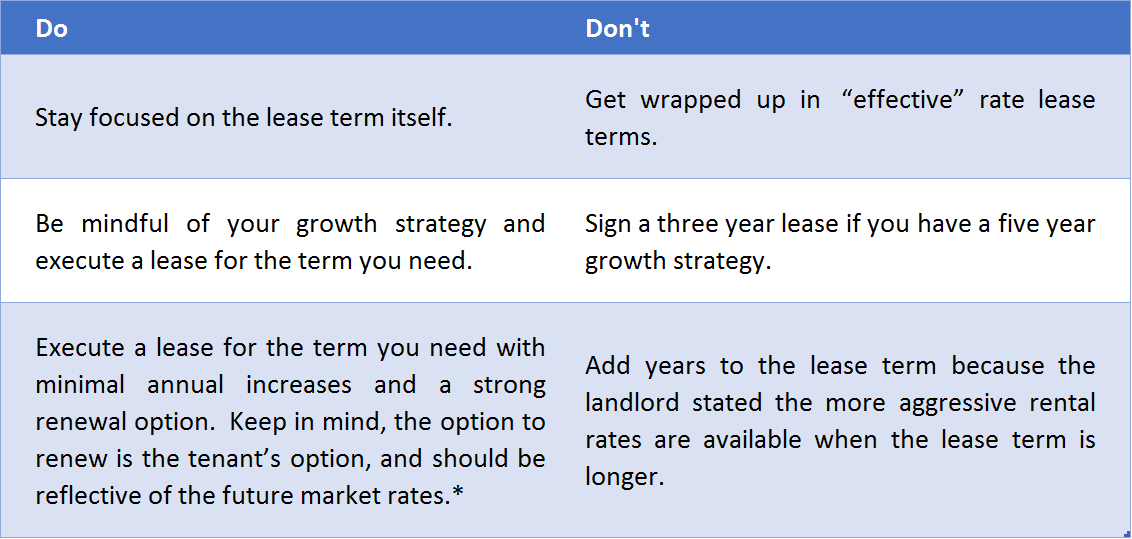3 Points to Remember to Keep You Feeling Good About Your Office Lease Throughout the WHOLE Term
By James (Jay) Rigelsky on Jun 9, 2018

Every day, businesses and their leadership face a number of extraordinarily stressful situations when attempting to make the “best choices” for the immediate and long-term future of the business.
Whether a company has one, two, or multiple office leases, each lease negotiation is both exciting and stressful. Many times, the up-front business terms of a lease, give the appearance that the entire lease term is going to look as manageable as years 1 and 2.
The reality, however, is that the “abated rent period,” (a low first-year base rental rate typically offered with no OPEX costs), can provide a misleading impression that the entire lease term is going to be a manageable fixed cost.
To ensure you experience the same level of success in Year 5 and beyond of an office lease, keep these three points top of mind during negotiations with the landlord.
Remember, the landlord needs you as a tenant just as much as you need a front porch for your business.
- Leverage. The party that has leverage and properly deploys it, typically experiences less headaches during the negotiations phase. Finding office space is stressful, and in the case of relocating an office, the move can be even more demanding. To create tenant leverage, leadership must not procrastinate and should be realistic that a new office lease must be negotiated.Time is of the essence, and having TIME to make your “front porch” selection is key to creating an advantage. Another factor that establishes positive negotiating leverage for the tenant is having at least one other viable office choice — not a “back-up,” but a viable alternative option. A practical second option removes the “emotion” from the negotiation and allows you to manage your expectations and not tip your need for the space to the landlord. Tenants do not get what they want all the time, they get what they negotiate. By granting your tenant representative the ability to remove the emotional aspect from the decision, you can effectively cultivate a leveraged negotiation process with the landlord.
- Term vs. Rates. Many tenants begin to focus on the lease rates, abated rent, etc., and the positive effect these costs and concessions may have on the current and subsequent years’ budget.Do’s and Don’ts When Assessing Term vs. Rates

*Have your representative remove any language stating the renewal period rental rate will not be less than the last year’s then in effect rental rate. Is that really a renewal option? No, it’s a dictated term.
- Operating Expenses. Making Sense of OPEX Exclusions, Controllable Expense Cap and the Right to Audit operating expenses (building management and maintenance costs, security and capital building improvements).
Make sure to review the following:
OPEX Exclusions
Thoroughly review all OPEX costs reimbursable to the landlord during your tenancy.
- Maintenance and repair reimbursements (parking area repair and maintenance)
- Employee, property manager, and building engineer salaries
- Determine what the landlord considers a capital expenditure (as opposed to an immediate reimbursable), and then insert the proper language in the lease that mitigates your risk (roof electrical and plumbing system).
- Ensure the landlord does not include any financing costs that the landlord is not entitled to.
- Review marketing costs included in reimbursable expenses
Controllable/Non-Controllable Expenses
Taxes, Utilities, and Insurance are considered “non-controllable” expenses; all other OPEX are “controllable”
- Have your tenant representative outline the “controllable” expenses to you
- Require the landlord to cap “controllable” expenses at a fair percentage over the previous year’s expenses.
Obtain the right to audit all expenses before reimbursing the landlord.
It is your company’s money. Remembering these tips during office negotiations will ensure you keep more of it so you can invest more in your company and your people.




